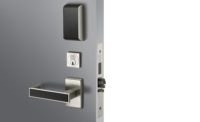SDM brought together three systems integrators to discuss wireless access control: Jim Huber, general manager, NorCom Inc., Heborn, Ky.; Chris Wise, co-founder and managing partner, Security 101, Marietta, Ga.; and Tim Feury, president, Altec Systems, Marietta, Ga.

President
Altec Systems
SDM: When it comes to access control, which do you prefer to work with, hardwired or wireless?
Jim Huber: I like wireless on remote access points or perimeter entry because the labor involved for getting the network out to that point can be difficult. For those internal to a building I prefer wired. It is a more robust, secure access at that point. There are two different schools of thought depending on proximity to building and proximity to ease of pathway, so to speak.
Chris Wise: Do we have a 100 percent comfort level with wireless? No. Our engineering staff is still in that testing phase of what is the best product. We don’t have a standard product that we use for wireless access. When we get a wireless project, there is always that look in their eyes of, ‘well….’
When do we use wireless and not hardwired? Truly that is all relative to cost and distance. That may be a close-minded approach.
Tim Feury: For me, my preference would be hardwired. If I can get a wire there I feel long term there are less things to worry about regarding stability.
I think the benefit of wireless technologies, if there is no RF interference or any other atmospheric conditions that cause it to be inconsistent, is that you don’t have to get wire there. Sometimes it may not be physically possible to do so. It’s also a quicker install. I look at using wireless when it is really the only feasible way to do it. It allows me to put a reader in an area where customer would not ordinarily do it. It is my last resort technology.

General Manager
NorCom Inc.
SDM: When you talk about wireless access, how do you define that?
Chris Wise: There is a difference in my mind between “wireless” and “wire-free.” Wireless is a technology that enables me to communicate from a peripheral device to a managing device via wireless protocol. I still have a traditional access control system. It’s like this phone call: The only difference is that instead of my voice getting to you over copper, it gets to you over wireless protocol. But the conversation doesn’t change. Access control panels operate the same way. A wire-free solution is not sending information back to a centralized device. It is sending it via credential. The information is collectively captured on that credential. Then when you go to a device that is wired, it takes that off the card and deposits it correctly.
Co-founder / Managing partner
Security 101
SDM: What do you feel needs to happen for wireless to gain more acceptance and wider use in the access control arena — and for you to feel more comfortable employing it?
Jim Huber: I think wireless will be a larger and larger part of the market as companies go towards more and more wireless integration within their buildings. The reason it isn’t as popular yet is that people don’t have the wireless infrastructure. Once again, it goes to the sense of insecurity when you have a wireless network as opposed to wired.
Chris Wise: In wireless we are starting to see that large wireless network environment. We in security tend to be about two years behind the IT infrastructure. Do I think that one day we will have a wireless access control environment? Yes. One day we will sit back and laugh about the miles and miles of copper we pulled through these buildings.
As to the when and where of hardwire versus wireless I think it will happen when the technology becomes robust, secure and affordable enough. There also has to be acceptance from the marketplace. There is still a tendency to not fully embrace wireless technology because of issues over years.
But it is going to continue to grow. I believe that. Five years ago, my less-than-five percent wireless business was less than .05 percent. The trend will be to five, 10 or 50 percent. And that could happen in a matter of months. I certainly see our society totally embracing wireless technologies. We do it everywhere. We see [the Internet] in coffee shops. Many homes don’t even have a wired telephone.
Tim Feury: I don’t know if I would 100 percent agree with that. Any time you have a wireless network point you by definition have a greater security issue. I think IT departments are actually going to be slower to accept wireless for access control over just putting an edge device at the door. That is going to be a big hurdle. The IT department will perceive that as a red flag and are going to want to be very confident that it won’t pose a security risk on their network.
Here’s what drives it in my mind. If a wired reader costs $3,000 and so does wireless, you would go wired. If you can get wireless for $1,500, you will look at wireless. You have got to get over that IT hurdle. I don’t think in five to 10 years there will be more wireless readers than wired unless copper goes through roof and is not practical. If the price points are close I think customers would prefer a wired reader.
SDM: What applications do you feel do lend themselves to wireless access control?
Jim Huber: If you are controlling, say, a perimeter and you are talking about outlying areas. There are companies with expanses of space around their building and they want to use access control into those areas such as parking and other offsite facilities. They may have electric out there for running shelters or lights, but they won’t have data. What we do is say ‘how cost effectively can we do this?’ If it’s a quarter mile away and we don’t want to trench to get a data cable out there, we can use a wireless access point to gain that. It works out great in that world.
Chris Wise: I would say a wireless application is needed if I am working in an environment where I have multiple doors. A good example is a dormitory where they don’t need time schedules, and they are not required to provide door position or integrate into a security management suite. In those applications wireless works very cost effectively.
SDM: What lessons have you learned from installing wireless access and what advice would you offer other integrators?
Jim Huber: We have had times where the corporate initiative to us was ‘This is what we want and this piece is wireless.’ We have had IT departments then say ‘No, I am not going to allow this because of issues on security, points of failure.’ If corporate tells IT to install it anyway, that is a recipe for failure for everyone involved. If you don’t have buy-in and a department is made to do something, that is being short-sighted.
If you work closely with the IT department, wireless can be very beneficial and cause cost savings to the client because of the ability for you to utilize a wireless network connection for that point. But if you do not work closely with IT, I would suggest steering away from wireless and going with hardwired because of issues you are going to see as the integration person and the perceived malfunction of those units. It really comes down to how well an integrator works within the IT world and the organization that is sponsoring the project.
Chris Wise: When you are able to employ wireless right, it works well, but there are still significant challenges with wireless such as line of sight. If you know how to engineer it, yes it is a proven technology and good solution.
Tim Feury: We have run into that situation on point-to-point wireless. We had a distribution facility where the only place we could position the wireless access, every time a truck came in we lost the line of sight. Be aware of all the things you need to be aware of every time you put wireless in.



